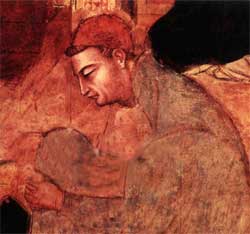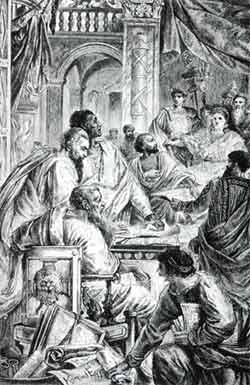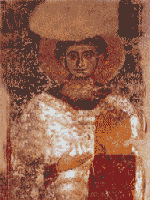
Arius, Heresy and Tradition
by Rowan Williams
Alexandrine Presbyter and founder of Arianism. Arius was born in Libya, North Africa. He became known abroad in 318 A.D. for his peculiar views on the Trinity. If the Son were truly a son, then at one time He was not. This controversy rapidly spread throughout the church, and was condemned by 100 Egyptian and Libyan bishops. Eventually the controversy attracted the attention of Constantine, and in 325 A.D. called for a settlement of the dispute through the Council of Nic?a. Here is when Athanasius became widely known as chief opponent to Arius, and the controversial idea condemned. The writings of Arius were publicly burned and denounced, while Arius was banished to Illyria. In following centuries however, the controversy still held significant importance. Even in the present day, the beliefs of Arius are still found in Christian theology, though condemned as heretical among Orthodox churches.
The Arian Controversy
Christianity had been involved in such theological controversies since Paul's time. In Paul's day, the relationship between Jewish and Gentile converts was on everyone's lips. Then came the Gnostic speculation. These early controversies were no small matter, often sides drawn in bitter opposition. But in early Christianity, solid argument and righteousness was the only means to win a debate. Such controversies were given no real attention by civil authorities and confined within the church, therefore those in conflict had little desire to involve the authorities.
Following Constantine's conversion to Christianity, things were changed for Christianity, including the authority of the state to exercise its power in the settlement of theological disputes. Constantine had a vested interest in the unity of the church, hoping it would be the "cement of the Empire." This church-state alliance began using its power to force theological agreement on its citizens. In difference to times past, when Christians tolerated prolonged theological controversies, through means of imperial authority such controversies were now brought to a swift end. Therefore, those in controversy, sought to convince the emperor rather than their opponents, or the church.
So was the case with the Arian controversy. It began with conflict between a bishop and a priest, growing to such a point that intervention from Constantine was invoked, with each party hoping to destroy the other through political maneuvers.

The Trinity was sometimes depicted as three faces belonging to single body in medieval art.
The Outbreak of the Controversy
The roots of the Arian controversy are to be found in theological developments that took place long before the time of Constantine. Indeed, the controversy was a direct result of the manner in which Christians came to think of the nature of God, thanks to the work of Justin, Clement of Alexandria, Origen, and others. When the first Christians set out to preach their message throughout the Empire, they were taken for ignorant atheists, for they had no visible gods. In response, some learned Christians appealed to the authority of those whom antiquity considered eminently wise, the classical philosophers. The best pagan philosophers had taught that above the entire cosmos there was a supreme being, and some had even declared that the pagan gods were human creations. Appealing to such respected authorities, Christians argued that they believed in the supreme being of the philosophers, and that this was what they meant when they spoke of God. Such an argument was very convincing, and there is no doubt that it contributed to the acceptance of Christianity among the intelligentsia.
But this was also a dangerous argument. It was possible that Christians, in their eagerness to show the kinship between their faith and classical philosophy, would come to the conviction that the best way to speak of God was no longer that of the prophets and other biblical writers, but rather that of Plato, Plotinus, and the rest. Since those philosophers conceived of perfection as immutable, impassible, and fixed, many Christians came to the conclusion that such was the God of Scripture.
Two means were found to bring together what the Bible says about God and the classical notion of the supreme being as impassible and fixed. These two means were allegorical interpretations of scriptural passages, and the doctrine of the Logos. Allegorical interpretation was fairly simple to apply. Wherever Scripture says something "unworthy" of God --that is, something that is not worthy of the perfection of the supreme being --such words are not to be taken literally. Thus, for instance, if the Bible says that God walked in the garden, or that God spoke, one is to remember that an immutable being does not really walk or speak. Intellectually, this satisfied many minds. But emotionally it left much to be desired, for the life of the church was based on the faith that it was possible to have a direct relationship with a personal God, and the supreme being of the philosophers was in no way personal.
There was another way to resolve the conflict between the philosophical idea of a supreme being and the witness of Scripture. This was the doctrine of the Logos, as developed by Justin, Clement, Origen and others. According to this view, although it is true that the supreme being --the "Father" -- is immutable, impassible, and so on, there is also a Logos, Word, or Reason of God, and this is personal, capable of direct relations with the world and with humans. Thus, according to Justin, when the Bible says that God spoke to Moses, what it means is that the Logos of God spoke to him.
Due to the influence of Origen and his disciples, these views had become widespread in the Eastern wing of the church --that is, that portion of the church that spoke Greek rather than Latin. The generally accepted view was that, between the immutable One and the mutable world, there was the Word or Logos of God. It was within this context that the Arian controversy took place.

A yet un-baptized Emperor Constantine presiding over the Council of Nicea
The controversy initially began in Alexandria, when the bishop Alexander disputed over several issues with Arius. The main issue in controversy was whether or not the Word of God was coeternal with God; "there was when He was not", became the Arian motto. Arius believed the Word was not coeternal with God, while Alexander argued the Word existed eternally, with the Father. The matter may appear trivial on the surface, however, the divinity of the Word was at stake.
Arius argued, the Word was not God, but the first of all creatures {it should be noted: Arius did not deny the Word existed before the incarnation of Christ}. All were in agreement on the pre-existence of the Word, but Arius' view held that before anything was created, the Word was created. Alexander's argument was the Word being divine could not have been created, but coexisted eternally with God. To better explain, if to make a distinction between God and Creation, Arius would place the Word on the side of creation, while Alexander would place the Word on the side of God.
Constantine intervened, first by dispatching Bishop Hosius, a personal advisor in ecclesiastical affairs. When the bishop reported the controversy was beyond simple reconciliation, Constantine called for a great assembly of bishops to resolve the matter.

Arius
CREED OF NICEA
And we believe? in one Lord Jesus Christ, the son of God, begotten from the Father as the only-begotten, that is, from the substance of the Father, God from God, light from light, true God from true God, begotten, not made, being of one substance with the Father . . .
References
- Funk and Wagnalls Encyclopedia ©1950
- The Story of Christianity by Justo L. Gonzales


No comments:
Post a Comment